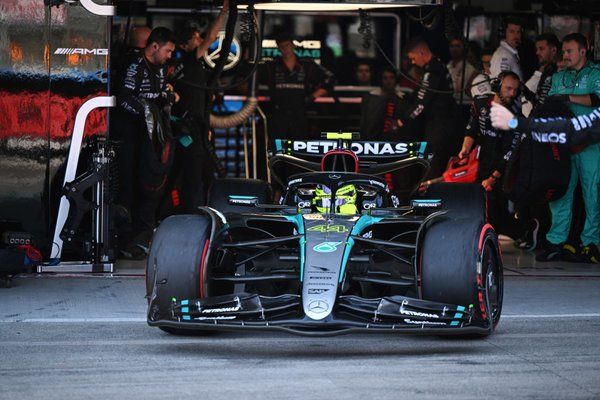Verstappen not a fan of F1's active aero plans for 2026
World champion Max Verstappen does not think Formula 1 should be heading in the direction of active aero – as he believes the focus should instead be on reducing the weight of the cars.

Andy Hone / Motorsport Images
As the FIA continues its efforts to finalise the new car regulations from 2026, Autosport revealed earlier this week that some alarming simulator findings have prompted a rethink about how the active aero elements of the new F1 challengers will work.
Whereas initial investigations focused on only having the rear wing as a moveable element, it has now been decided that the front wing will also need to be adjustable for aero-balance reasons.
This move was triggered by simulator runs highlighting that there was a high risk of cars spinning when the rear wing was in low-drag mode.
Verstappen thinks that F1 is looking in the wrong direction though in chasing complex elements like active aero, and instead says bigger improvements could come if there was a big push to bring down car weight.
Asked by Autosport for his thoughts on the 2026 plans, Verstappen said: “With the potential like active aero and stuff, I'm not sure if we should head into that direction - but that's what it's looking like at the moment.
“Hopefully, we can optimise all these kinds of things.
“For me, it's more important to just try and fight the weight of the cars, try and optimise that instead of all these tools and tricks to try and help the overtaking or following. There must be different ways to be able to do it.”
The moveable aero element has become essential because the 2026 car designs need to compensate for the unique performance characteristics of the new power units.

Max Verstappen, Red Bull Racing RB20 Charles Leclerc, Ferrari SF-24
Photo by: Zak Mauger / Motorsport Images
The planned 50/50 split between the internal combustion engine and battery means that power will be down overall and could run out at the end of straights.
This is why the FIA wants the wings to run in a high-downforce configuration in corners before switching to low drag on the straights for better straightline speed.
Verstappen added: “With the engine regulation that they went into, they kind of need to do that to create the top speed where the battery stops deploying and stuff.
“Some tracks will work a bit better, and some tracks probably it's a bit more on the edge.
“Of course, people will try to counter my arguments, but I guess we'll find out anyway in ’26.”
Ferrari’s Carlos Sainz backed Verstappen’s scepticism about the active aero element of the 2026 cars, as he said things looked like they had got overly complicated.
“I think it's all a consequence of the engine regulations,” he said.
“In the end, if you have a lot more energy requested from the electric powertrain, you're going to need to have, in a way, active aerodynamics to compensate.
“And this is where it all starts to get messy with the overtaking and the active aero, and how you can do that to help the car to go quicker on the straight and spend less time full throttle.

Carlos Sainz, Scuderia Ferrari, 3rd position
Photo by: Sam Bloxham / Motorsport Images
“Anyway, until we try them, it is I think unfair to criticise or to back the regulation change. And at the same time, if it has attracted manufacturers, big manufacturers like Audi, into the sport, I think it's something that has to be appreciated and put into context.”
Sainz echoed Verstappen’s view that car weight should be one of the factors made a priority when it comes to improving things – as he also reckoned active suspension should make a return.
“My personal view is that these cars now are probably just too big and too heavy,” he added.
“If I would have to change something for tomorrow, it would be that. And then the suspension, I think the suspensions are becoming a big talking point in a lot of the tracks, and how taxing it can be for the driver.
“So, if I would have to request something to the FIA for 2026, if we are going to have active aero, why not active suspension to protect the back of the drivers and to protect our own health and the safety of certain tracks?
“It's clear that right now we are asking way too many things to the tracks and to the circuits, to the organisations, to change many small bumps that before we wouldn't even feel with the ‘21 car, and now we just can spin or have a pretty big accident because of those situations.”
Be part of the Autosport community
Join the conversationShare Or Save This Story
Subscribe and access Autosport.com with your ad-blocker.
From Formula 1 to MotoGP we report straight from the paddock because we love our sport, just like you. In order to keep delivering our expert journalism, our website uses advertising. Still, we want to give you the opportunity to enjoy an ad-free and tracker-free website and to continue using your adblocker.





















Top Comments